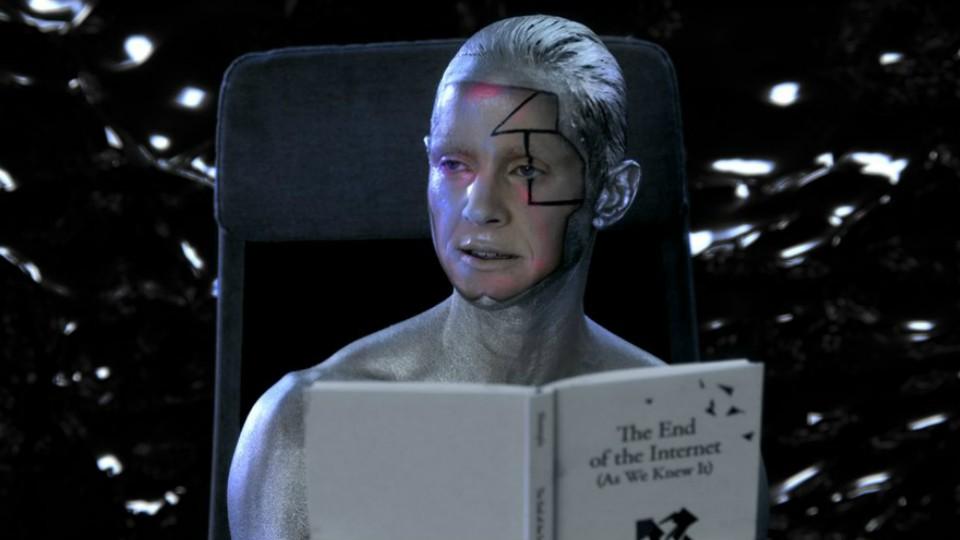Imagining the internet of the future
Primary page content
An artist from Goldsmiths, University of London, is set to open a new exhibition which confronts the growing hegemony of the internet.

Film still from Jubilee 2033
Dr Zach Blas, Lecturer in Visual Cultures, opens Contra-Internet at Gasworks Gallery in London on Wednesday 20 September.
The installation, which will be in place until Sunday 10 December, features a range of exhibits including blown glass sculptures, CGI animations and Blas’ debut short film.
Ahead of the opening, I asked Zach about the concept, the making of the film and his research into alternatives to the worldwide web.
Chris Smith: Tell us a little bit about the installation…
Zach Blas: It includes a huge range of exhibits, ranging from blown glass sculptures to CGI animations, all of which discuss the increasingly ‘all-powerful’ nature of the internet. It also includes my 30-minute film called Jubilee 2033, which imagines a chaotic and dystopian future under a deregulated and omnipotent worldwide web.
The project is primarily funded by an organisation in the US called Creative Capital. They give grants to artists at pivotal moments in their career as a once in a lifetime thing, which has allowed me to invest in the project. I also received a grant from the Arts Council in the UK.
CS: What is the plot of Jubilee 2033?
ZB: It starts in 1955 in New York with Ayn Rand – a novelist and thinker who is very influential in Silicon Valley because of her work called ‘The Virtues of Selfishness’. She had a group of followers called The Collective, and in the film they are visited by an AI hologram which reveals to them the future of Silicon Valley in 2033. It turns out to be a disintegrating, crumbling rubble where the internet, after decades of deregulation, has become omnipotent and is policed by an oppressive state monopoly.
Inside a burning building, a faction of students is taught history, politics, art and what to do if the internet were to collapse. They eventually rise up and attack the existing system, with chaotic consequences. The final scene of the film sees the AI hologram holding a raw chunk of silicon on Silicon Beach (so called because of proximity to the tech metropolis). The chunk of silicon confronts her with the material reason for her existence and evokes questions of technological waste and its effects on the world.
CS: What was your inspiration for the project?
ZB: When I was at art school, I studied with an artist called Ricardo Dominguez, who came up with the term ‘utopian plagiarism’. This is the idea of taking a term, slightly tweaking it and seeing what new types of thought might be produced. This is how I came up with ‘Contra-Internet’, which is a concept I loved.
I’m interested in two big questions with the internet. Firstly, how did we get from the ‘90s where there was a lot of talk of it being a potential site of liberation and freedom, to skipping a relatively short period in time where we’re in a different place, where the internet is completely connected with governance, surveillance and abuse?
Secondly – why is it so hard to imagine an alternative to the internet? There is no conception of any other model than the internet. It’s a vast, mind-boggling question but as an artist, it’s an exciting one. I have tried to address this in the exhibition with the display of the one-off publication ‘The End of the Internet (As We Know It).
CS: Through your research, did you discover any examples of groups working on alternatives to the internet?
ZB: During the early stages of the project I found that there are activist groups all over the world developing infrastructural alternatives to the internet. A lot of it will happen in politically volatile situations. For example, during the Occupy Wall Street demonstrations, the group developed a series of wireless mesh networks through which they were able to connect with each other without needing any commercial internet infrastructure. There was a similar system to this being developed in Detroit, and it was also a big part of the pro-democracy protests in Hong Kong in 2014. Examples like this offer a glimmer of hope that there might be a vision for something else.
CS: Are their further plans for this installation after its London residency?
ZB: Its last day in London will be Sunday 10 September, and then in the New Year it will be presented at Art in General in New York City. This will run from January until March, and from May to July 2018 it will be at the MU art space in Eindhoven. I’m really excited that it’s going to be on show in such innovative and creative spaces.
Contra-Internet will be on public display from Thursday 21 September to Sunday 10 December at Gasworks Gallery, 155 Vauxhall Street, London, SE11 5RH.